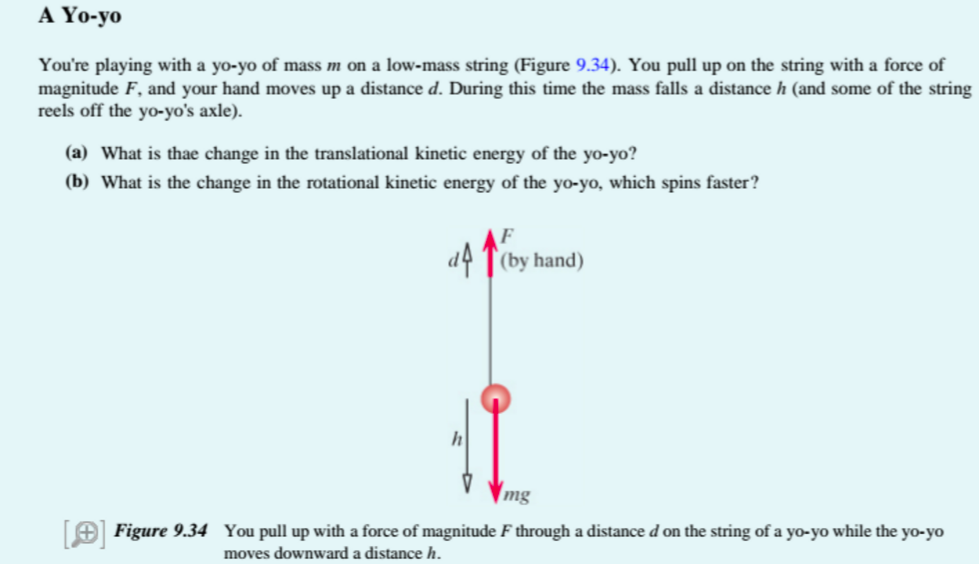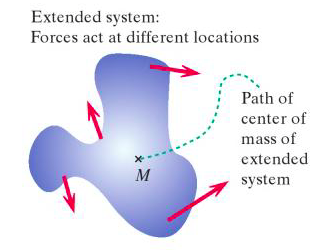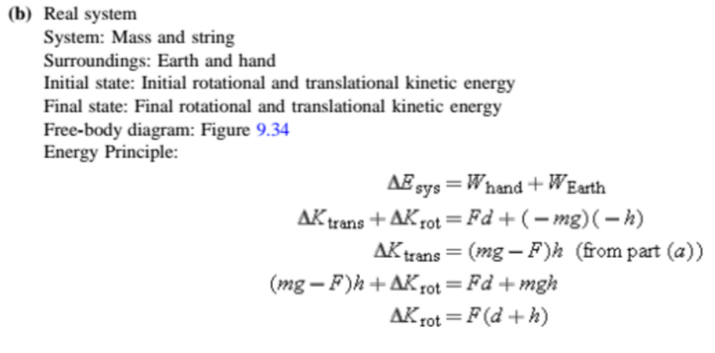Work and Energy for an Extended System
"Work and Energy for an Extended System" in progress by Morgan LaMarca
The Main Idea
Unlike the point particle system where the only energy possible is translational kinetic energy, an extended object can rotate, vibrate, and change shape. Though the point particle system and the extended system both have the same total mass, and are both acted on by the same net force, the point particle system, has no rotational motion, vibrational motion, or internal energy because all of the forces act at the location of the point particle. In contrast, forces act at different locations on the mass in an extended system, thus causing them to rotate, vibrate and stretch. Because of these qualities, not every part of the system always moves in the same direction as the center of mass moves.
When calculating work done on an extended system, the displacement of every point where a force is applied must be considered separately, because it matters where each force is applied.
A Mathematical Model
Work and Energy for an Extended System:
![]()
This equation assumes that each force is constant during the displacement. If each force is not constant during the displacement, the work of each force as an integral of [math]\displaystyle{ \vec{F}_{i}•d\vec{r}_{i} }[/math] must be calculated either analytically or numerically.
A Computational Model
A Jumping Kangaroo Modeled as an Extended Object:
If one were to model a jumping kangaroo as a point particle system, the change in translational kinetic energy could be derived. However in the real world, Kangaroos are not a point particle, but rather an extended system where energy changes occur in the legs and arms of the kangaroo relative to the center of mass. Chemical energy and thermal energy are just two more examples of energy changes that may occur in extended systems but not in point particle systems.
The work done on a point particle system is not the same as the work done on an extended system. Because forces are applied in many different locations on the mass in an extended system, sometimes these forces act through different distances than the displacement of the center of mass of the system, for different sections of the system move different distances. The following free-body diagram a modeled extended system illustrates how these individual forces may act at different locations:
When considering all the possible changes in energy when a Kangaroo jumps, the energy equation for the Kangaroo modeled as an extended system (ignoring Q, or the transfer of energy due to a temperature difference between the Kangaroo and the surrounding air), should look like the following equation:

The change in relative kinetic energy and the change in internal energy do not appear in the energy equation for the point particle system because the point particle system only focuses on the translational motion of the center of mass point. The change in relative kinetic energy includes the rotation of the legs and the swinging of the upper body and tail of the Kangaroo. The change in internal energy includes the increase in thermal energy of the Kangaroo's body and the decrease in chemical energy that was previously chemically stored in the Kangaroo's body. This computational model of the jumping Kangaroo allows one to visualize how unlike the point particle system, the extended system changes shape due to the bending of the legs, arms, and torso of the Kangaroo during the jump.
Example
Simple
Example 1: A Yo-yo
 link title(Chabay)
link title(Chabay)
Solution
(a)
System: Point Particle
Surroundings: Hand and Earth
Initial State: Point particle with initial translational kinetic energy
Final State: Point particle with final translational kinetic energy
Energy Principle (keep in mind that point particle systems only have translational kinetic energy!)

Solution
(b)
Connectedness
- How is this topic connected to something that you are interested in?
- How is it connected to your major?
- Is there an interesting industrial application?
History
Put this idea in historical context. Give the reader the Who, What, When, Where, and Why.
See also
Are there related topics or categories in this wiki resource for the curious reader to explore? How does this topic fit into that context?
Further reading
Books, Articles or other print media on this topic
External links
Internet resources on this topic
References
This section contains the the references you used while writing this page

